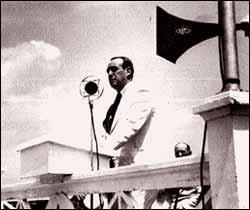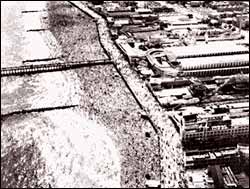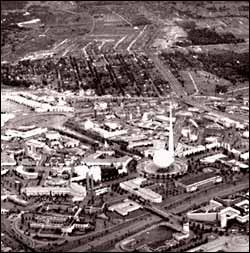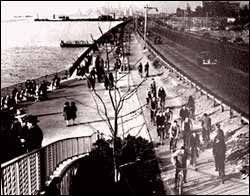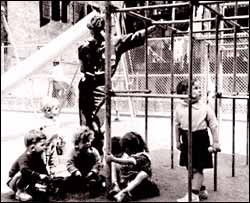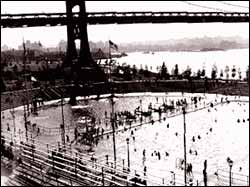Robert Moses and the Modern Park System (1929-1965)
1929
In August 1929, Long Island State Park Commissioner Robert Moses opened Jones Beach State Park. The sumptuous bathhouses, campanile water tower, and parking lots for thousands of cars at Jones Beach were unprecedented for a public beach anywhere. The popularity of Jones Beach was comparable to the success of Central Park 71 years earlier: 350,000 people crowded into the park during its first month of operation alone. Moses' Long Island parks became models for the development of parks in New York City in the next decades.
1930
As chairmen of the New York Park Association's Metropolitan Conference on Parks, Robert Moses was already planning for the park needs of New York City in the late 1920s. In 1930, the Metropolitan Conference issued a report recommending immediate acquisition of thousands of acres of the last natural areas in the city. In order to solve the city's traffic problems, a system of parkways was also recommended, including the Belt, Grand Central, Cross Island and Henry Hudson Parkways. Much of the park and parkway construction supervised by the Parks Department in the 1930s was guided by this planning report.
1933
Franklin D. Roosevelt inaugurated his new Deal for the American people. This era of federally sponsored public works projects led directly to the development of parks; only highway projects were to have a bigger share of New Deal spending than public recreation projects. The result of the Works Progress Administration and other New Deal programs were especially evident in New York City.
1934
Mayor Fiorello H. La Guardia discontinued the five independent, borough Parks Departments, and appointed Robert Moses sole commissioner of a unified Department of Parks for New York City. Moses also retained his state park offices, and was named to head the Triborough Bridge Authority and other public works authorities. At the Parks Department headquarters in the Arsenal, an enormous park design and construction team assembled. Architect Aymar Embury II and landscape architect Gilmore D. Clarke were among the 1,800 designers and engineers drawing up plans for the expansion, rehabilitation and modernization of New York's parks. An additional 3,900 construction supervisors oversaw the work of an army of Parks Department relief workers—70,000 strong in 1934—all paid by the federal government.
1936
The fruits of the New Deal and of Moses' organizational genius were evident all over the city. In these first years, hundreds of playgrounds were built. Three zoos, 10 golf courses and 53 recreational buildings were completed. Orchard Beach opened in the Bronx, and Jacob Riis Beach opened in Queens. Perhaps most impressively of all, 11 enormous outdoor pools with an average capacity of 5,000 people each opened in neighborhoods all over the city during the sweltering summer of 1936.
Parkways, now defined as modern highways isolated in a ribbon of parkland, were an important part of the new parks system. By 1936 the Grand Central, Interborough and Laurelton Parkways opened. The Triborough Bridge, the heart of the city's new arterial system, opened in July. The Henry Hudson Bridge and the first sections of the Henry Hudson Parkway opened on December 12, 1936.
1938
The Corporation Counsel of the city transferred jurisdiction over the beaches and boardwalks at Coney Island in Brooklyn, Rockway in Queens and South Beach on Staten Island from the Borough Presidents' Offices to the Parks Department. Moses' improvements for these areas featured increased beach and swimming areas and improved automotive access, as well as a reduction in amusement attractions.
1939
The World's Fair opened in Flushing Meadows Corona Park in 1939. Planning for the Fair had begun in 1936 and drew heavily on the Parks Department's expert design and construction staff. The former swamp and ash dump was filled in and converted into a 1,200-acre fair site, which in turn became Flushing Meadows (later Flushing Meadows-Corona) Park.
1940
The Parks Department completed the Belt Parkway from Owl's Head Park in Brooklyn to the Bronx-Whitestone Bridge in Queens, a distance of almost 35 miles. The Belt Parkway, the most ambitious of all the pre-war parkway projects, was composed of the Shore, Southern and Cross Island Parkways which ran through or adjacent to Owl's Head, Dyker Beach, Marine, and Canarsie Beach Parks in Brooklyn and Spring Creek, Baisley Pond, Brookville, Alley Pond, Crocheron and Clearview Parks in Queens.
1942
Gracie Mansion in Carl Schurz Park became the official residence of Mayor La Guardia in 1942. The Mansion was built in 1799 by Archibald Gracie, who until his bankruptcy shortly before the War of 1812, was a prosperous merchant and host to such distinguished guests as Louis Philippe (later King of France) and Washington Irving. The city purchased the mansion in 1887.
1946
World War II halted public construction in New York as elsewhere; but between 1946 and 1949, $22.5 million from the city's budget was spent on the reconstruction of older parks, and on new recreational facilities. Scores of playgrounds were built as part of the postwar development boom. They were often financed together with school, public housing, and highway construction projects.
1954
The city acquired land which, combined with previously held city property, formed Jamaica Bay Park. Jamaica Bay Park, consisting of the south shore of Long Island within city limits plus several small islands, was preserved as a natural area.
1955
The Coney Island Aquarium, located between the boardwalk and Surf Avenue on Coney Island, opened in 1955. The aquarium replaced the old Castle Clinton Aquarium in Battery Park which had been a popular construction of the Brooklyn Battery tunnel.
1960
Robert Moses retired as Park Commissioner at age 72 to become the president of the 1964-65 World's Fair Corporation. When Moses became Park Commissioner in 1934 there had been 119 playgrounds in the city. In 1960 there were 777. The Parks Department under Moses also had built 15 outdoor swimming pools, 17 miles of beaches, and 84 miles of parkways. Park acreage had increased from 14,000 acres to 34,673 acres.
1964 A second World's Fair was held in Flushing Meadows-Corona Park from 1964 to 1965. The billion dollar development of the fair was complemented by the completion of nearby arterial routes such as the Van Wyck Expressway. Shea Stadium opened in Flushing Meadows-Corona Park as well. In 1972 the maintenance of Yankee Stadium in the Bronx also became a Parks Department responsibility.
